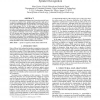Free Online Productivity Tools
i2Speak
i2Symbol
i2OCR
iTex2Img
iWeb2Print
iWeb2Shot
i2Type
iPdf2Split
iPdf2Merge
i2Bopomofo
i2Arabic
i2Style
i2Image
i2PDF
iLatex2Rtf
Sci2ools
ICASSP
2011
IEEE
2011
IEEE
Structural MAP adaptation in GMM-supervector based speaker recognition
In recent years, adaptation techniques have been given special focus in speaker recognition tasks, mainly targeting speaker and session variation disentangling under the Maximum a Posteriori (MAP) criterion. For these techniques, unseen mixtures are usually adapted in a global manner, if ever. In this paper, we explore Structural MAP (SMAP), Maximum a Posteriori adaptation using hierarchical structures of the acoustic space that allow data scarceness issues to be tackled with different precision levels. We explore this approach in a speaker verification system using a Support Vector Machine (SVM) classifier and Gaussian mean supervectors (GMM-SVM). We show that this is an effective approach that considerably outperforms its relevance MAP counterpart in the 2006 NIST Speaker Recognition Evaluation. We also show that using a speaker-adapted Universal Background Model can improve the stability of the clustering algorithm besides obtaining further improvements.
ICASSP 2011 | NIST Speaker Recognition | Signal Processing | Speaker Recognition | Speaker Recognition Tasks |
Related Content
| Added | 20 Aug 2011 |
| Updated | 20 Aug 2011 |
| Type | Journal |
| Year | 2011 |
| Where | ICASSP |
| Authors | Marc Ferras, Koichi Shinoda, Sadaoki Furui |
Comments (0)

